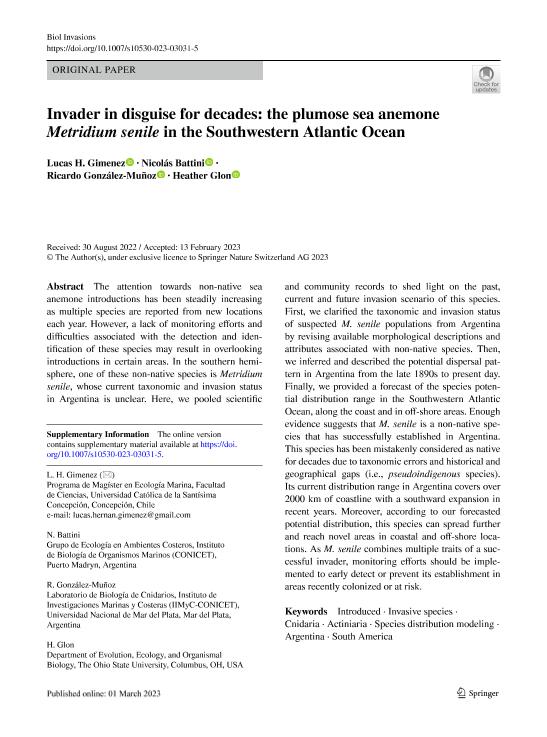Mostrar el registro sencillo del ítem
dc.contributor.author
Gimenez, Lucas Hernán

dc.contributor.author
Battini, Nicolás

dc.contributor.author
González Muñoz, Ricardo Enrique

dc.contributor.author
Glon, Heather
dc.date.available
2024-02-15T16:06:29Z
dc.date.issued
2023-03-01
dc.identifier.citation
Gimenez, Lucas Hernán; Battini, Nicolás; González Muñoz, Ricardo Enrique; Glon, Heather; Invader in disguise for decades: the plumose sea anemone Metridium senile in the Southwestern Atlantic Ocean; Springer; Biological Invasions; 25; 7; 1-3-2023; 2159-2173
dc.identifier.issn
1387-3547
dc.identifier.uri
http://hdl.handle.net/11336/227117
dc.description.abstract
The attention towards non-native sea anemone introductions has been steadily increasing as multiple species are reported from new locations each year. However, a lack of monitoring efforts and difficulties associated with the detection and identification of these species may result in overlooking introductions in certain areas. In the southern hemisphere, one of these non-native species is Metridium senile, whose current taxonomic and invasion status in Argentina is unclear. Here, we pooled scientific and community records to shed light on the past, current and future invasion scenario of this species. First, we clarified the taxonomic and invasion status of suspected M. senile populations from Argentina by revising available morphological descriptions and attributes associated with non-native species. Then, we inferred and described the potential dispersal pattern in Argentina from the late 1890s to present day. Finally, we provided a forecast of the species potential distribution range in the Southwestern Atlantic Ocean, along the coast and in off-shore areas. Enough evidence suggests that M. senile is a non-native species that has successfully established in Argentina. This species has been mistakenly considered as native for decades due to taxonomic errors and historical and geographical gaps (i.e., pseudoindigenous species). Its current distribution range in Argentina covers over 2000 km of coastline with a southward expansion in recent years. Moreover, according to our forecasted potential distribution, this species can spread further and reach novel areas in coastal and off-shore locations. As M. senile combines multiple traits of a successful invader, monitoring efforts should be implemented to early detect or prevent its establishment in areas recently colonized or at risk.
dc.format
application/pdf
dc.language.iso
eng
dc.publisher
Springer

dc.rights
info:eu-repo/semantics/openAccess
dc.rights.uri
https://creativecommons.org/licenses/by-nc-sa/2.5/ar/
dc.subject
ACTINIARIA
dc.subject
ARGENTINA
dc.subject
CNIDARIA
dc.subject
INTRODUCED
dc.subject
INVASIVE SPECIES
dc.subject
SOUTH AMERICA
dc.subject
SPECIES DISTRIBUTION MODELING
dc.subject.classification
Ecología

dc.subject.classification
Ciencias Biológicas

dc.subject.classification
CIENCIAS NATURALES Y EXACTAS

dc.title
Invader in disguise for decades: the plumose sea anemone Metridium senile in the Southwestern Atlantic Ocean
dc.type
info:eu-repo/semantics/article
dc.type
info:ar-repo/semantics/artículo
dc.type
info:eu-repo/semantics/publishedVersion
dc.date.updated
2024-02-06T14:53:54Z
dc.journal.volume
25
dc.journal.number
7
dc.journal.pagination
2159-2173
dc.journal.pais
Alemania

dc.description.fil
Fil: Gimenez, Lucas Hernán. Universidad Católica de la Santísima Concepción; Chile
dc.description.fil
Fil: Battini, Nicolás. Consejo Nacional de Investigaciones Científicas y Técnicas. Centro Científico Tecnológico Conicet - Centro Nacional Patagónico. Instituto de Biología de Organismos Marinos; Argentina
dc.description.fil
Fil: González Muñoz, Ricardo Enrique. Consejo Nacional de Investigaciones Científicas y Técnicas. Centro Científico Tecnológico Conicet - Mar del Plata. Instituto de Investigaciones Marinas y Costeras. Universidad Nacional de Mar del Plata. Facultad de Ciencias Exactas y Naturales. Instituto de Investigaciones Marinas y Costeras; Argentina. Universidad Nacional de Mar del Plata; Argentina
dc.description.fil
Fil: Glon, Heather. Ohio State University; Estados Unidos
dc.journal.title
Biological Invasions

dc.relation.alternativeid
info:eu-repo/semantics/altIdentifier/doi/http://dx.doi.org/10.1007/s10530-023-03031-5
dc.relation.alternativeid
info:eu-repo/semantics/altIdentifier/url/https://link.springer.com/article/10.1007/s10530-023-03031-5
Archivos asociados
